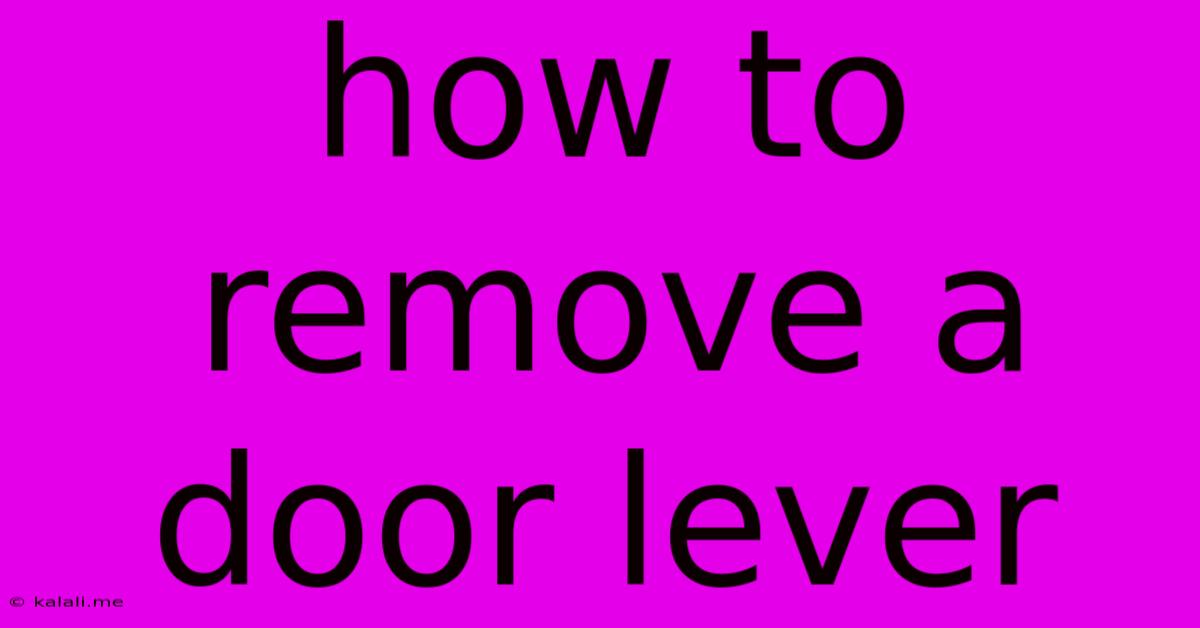How To Remove A Door Lever
Kalali
Jun 06, 2025 · 3 min read

Table of Contents
How to Remove a Door Lever: A Step-by-Step Guide
Meta Description: Learn how to easily remove a door lever with our comprehensive, step-by-step guide. We cover different lever types and provide tips for a smooth removal process, avoiding damage to your door.
Removing a door lever might seem daunting, but with the right tools and instructions, it's a manageable DIY project. This guide will walk you through the process, no matter the type of lever you have. Whether you're replacing a broken lever, upgrading your hardware, or simply need to access the door mechanism, this step-by-step guide will help you achieve a successful removal.
Tools You'll Need
Before you begin, gather the necessary tools to make the process smoother and safer:
- Screwdriver: You'll likely need both a Phillips head and a flathead screwdriver. Check your lever to see which type of screw head it uses.
- Small Pliers (optional): These can be helpful for gripping stubborn screws or small parts.
- Pencil or Marker (optional): Use this to mark the position of screws before removing them, ensuring you put them back correctly.
- Cloth or towel (optional): This is to protect your door from scratches.
Step-by-Step Instructions
The process generally involves these steps, although slight variations may exist depending on your specific door lever model:
1. Identify the Type of Lever:
There are various types of door levers, and the specific removal process may vary. Familiarize yourself with the type of lever you have. Common types include levers with visible screws and those with hidden screws.
2. Locate the Screws:
Carefully examine your door lever. Most levers will have screws visible on the lever's faceplates, often located on the rosette. Some modern levers have hidden screws that are concealed under decorative caps. If you have hidden screws, you might need a small tool to pry the cap off gently.
3. Remove the Screws:
Using the appropriate screwdriver, carefully remove the screws from the lever's faceplates. Take your time and be gentle to avoid stripping the screws. If the screws are stubborn, apply a little penetrating oil and let it sit for a few minutes.
4. Separate the Lever:
Once the screws are removed, gently pull the lever away from the door. Depending on the lever's design, this might involve separating the two parts of the lever (the handle and the latch mechanism).
5. Remove the Latch Mechanism (if necessary):
After removing the lever, you may need to access the latch mechanism inside the door. This usually involves removing a few more screws or using a flathead screwdriver to gently pry the latch mechanism from the door. This will depend on the specific door lever and its latch mechanism.
6. Clean up:
Once the door lever is removed, use a clean cloth to wipe the area to remove any dust or debris.
Tips for Success
- Take Pictures: Before you begin, take pictures of the lever and the screws' positions. This is helpful if you're unsure how to reassemble it.
- Be Gentle: Avoid using excessive force, as this could damage the door or the lever itself.
- Work Slowly: Patience is key. Rushing can lead to mistakes and potential damage.
- Consult the Manufacturer's Instructions: If you have any difficulties, check the manufacturer's instructions that came with the door lever. This information can often be found online.
Removing a door lever is a relatively simple task, but always prioritize safety and take your time. By following these steps and tips, you can successfully remove your door lever without any problems. Remember to consult a professional if you encounter any significant difficulty.
Latest Posts
Latest Posts
-
Actors In The Movie John Carter
Jun 06, 2025
-
How To Get Smoke Smell Out Of Apartment
Jun 06, 2025
-
Do Outside Users In Sharepoint Need Microsoft License
Jun 06, 2025
-
Kwik Plug Connected To Output Jack
Jun 06, 2025
-
Easier Way To Filer By Ssn In Sql
Jun 06, 2025
Related Post
Thank you for visiting our website which covers about How To Remove A Door Lever . We hope the information provided has been useful to you. Feel free to contact us if you have any questions or need further assistance. See you next time and don't miss to bookmark.